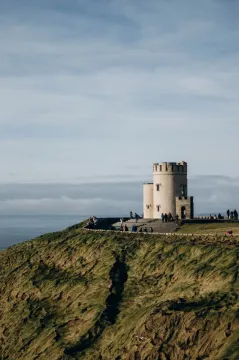Stories from Ireland: A Journey Through Time and Culture

Ireland is a land full of myths, legends and a rich history spanning thousands of years. This island country has witnessed great historical events, from the arrival of the Celts to the fight for independence in the 20th century. Every corner of Ireland seems to be steeped in fascinating tales that reflect not only its history, but also the essence of its people. In this blog, we invite you to explore some of Ireland’s most iconic stories that help us understand its culture and legacy.
- The Arrival of the Celts and the Pre-Christian Era
Ireland's history is deeply intertwined with the Celts, who arrived around 500 BC. They brought with them a rich culture, a complex social system and a deep reverence for nature. They are thought to have introduced the Gaelic language, which remains a fundamental part of Irish identity.
One of the most important legacies of the Celts is their mythology, which is filled with gods, heroes and mystical creatures. Among the most important figures in this mythology is Cúchulainn , the warrior hero whose story has been told throughout generations. Irish mythology is vast and continues to inspire literary and artistic works around the world. The Celts also built impressive monuments, such as the ring forts , which can still be found throughout the Irish countryside.
- St. Patrick and the Christianization of Ireland
One of the most important figures in Irish history is St. Patrick , the country's patron saint. Although he was not born in Ireland, but in Britain, he was brought to the island as a slave when he was young. He eventually escaped, but later returned to Ireland as a missionary.
Saint Patrick played a crucial role in the conversion of Ireland to Christianity during the 5th century. He is credited with explaining the Holy Trinity using the shamrock, a symbol that is associated with Ireland to this day. His mission helped transform Ireland into a center of Christian learning and culture in later centuries, with the founding of numerous monasteries and schools. Saint Patrick's Day , celebrated on March 17, has become one of the most widely recognized holidays worldwide.
- The Viking Invasions and the Founding of Dublin
Between the 8th and 11th centuries, Ireland suffered numerous Viking invasions, which left an indelible mark on the country's history. The Vikings, coming from Scandinavia, arrived on Irish shores in search of wealth, and although initially they only plundered monasteries and villages, they eventually settled down and founded important cities, including Dublin .
Dublin, founded in 841 AD, became a thriving trading centre under Viking control. Today, the Viking influence can still be felt in the Irish capital. The Viking legacy is also reflected in the city's archaeology and rich maritime history.
However, the relationship between the native Irish and the Vikings was not always peaceful. Over the centuries, the Irish fought to regain control of their lands, culminating in the Battle of Clontarf in 1014, in which the famous Irish king Brian Boru defeated the Vikings, although he was killed in the battle.
- The Norman Conquest
In 1169, Ireland was invaded by the Normans, a power that had previously conquered England. This invasion marked a turning point in Irish history, as it began a long period of English influence on the island. The Normans built castles and established lordships across much of the country. The most famous of these castles is Dublin Castle , which remains a symbol of British power in Ireland until its independence.
Despite the Norman Conquest, Irish culture and language survived, but the English presence laid the groundwork for centuries of conflict between the two countries. English rule was further consolidated over time, and Norman influence is visible in many medieval Irish towns and structures.
- The Great Famine (1845-1849)
One of the most tragic episodes in Irish history was the Great Famine of the mid-19th century. This disaster was caused by a series of poor potato harvests, the main food for the majority of the Irish population, and the ineffectiveness of the British government in managing the crisis. It is estimated that more than one million people died of hunger and disease, and millions more emigrated to countries such as the United States, Canada and Australia.
The famine had a devastating impact on Ireland's population and economy. It also heightened resentments towards British rule and was an important catalyst in the struggle for independence in the following decades. Today, there are memorials across the country commemorating the victims of this dark period in history.